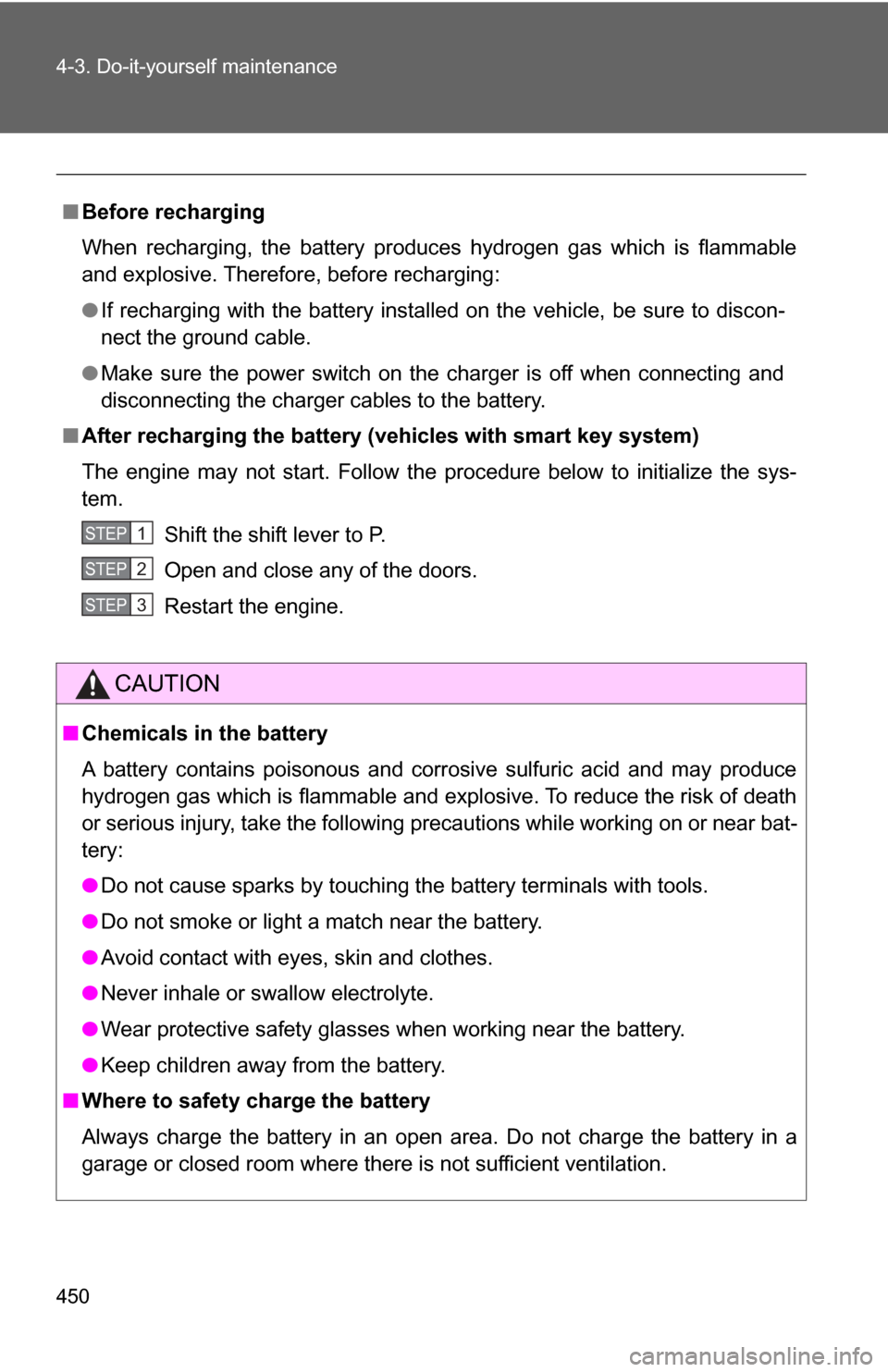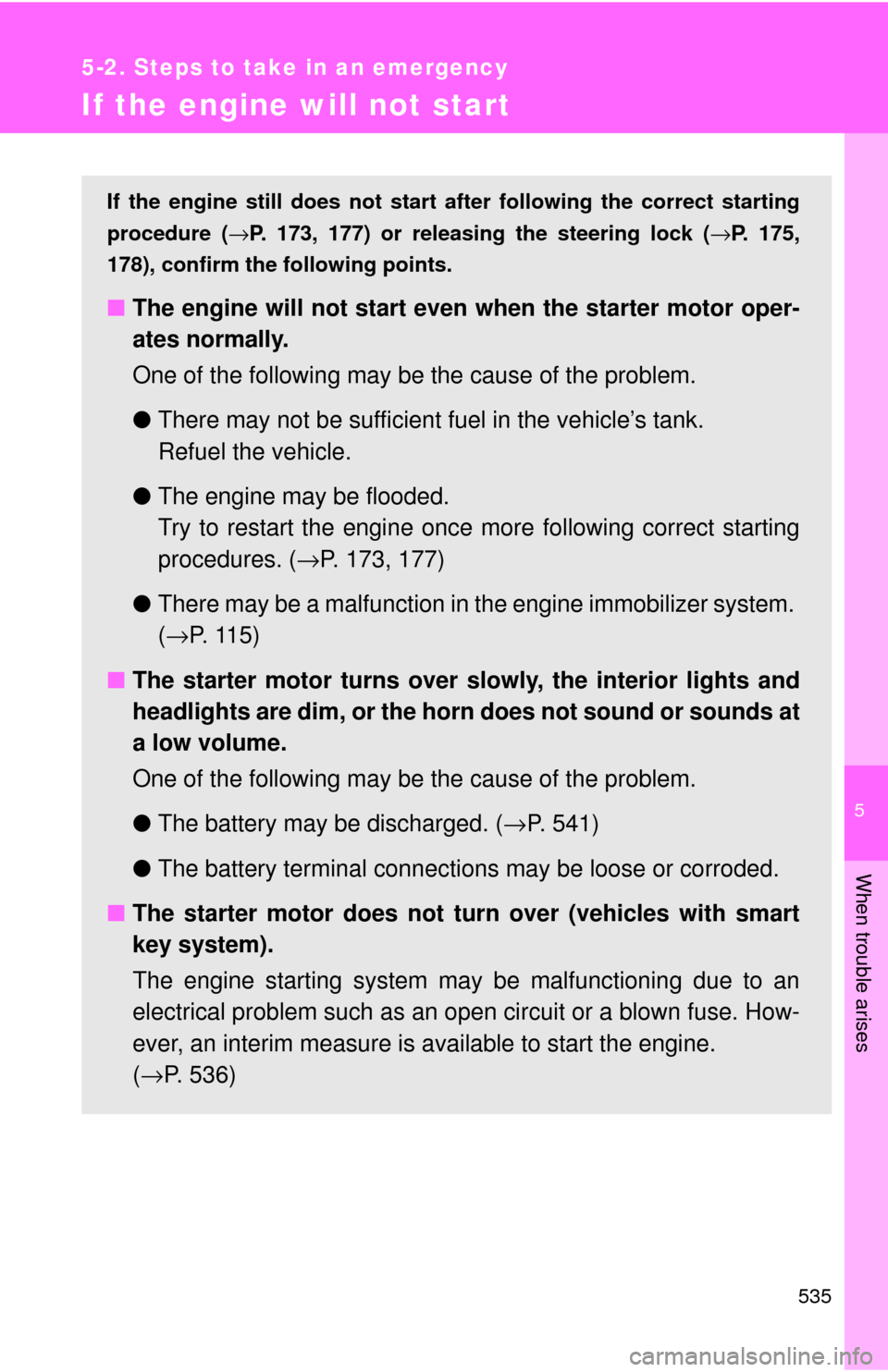Page 450 of 608

450 4-3. Do-it-yourself maintenance
■Before recharging
When recharging, the battery produces hydrogen gas which is flammable
and explosive. Therefore, before recharging:
●If recharging with the battery installed on the vehicle, be sure to discon-
nect the ground cable.
● Make sure the power switch on the charger is off when connecting and
disconnecting the charger cables to the battery.
■ After recharging the battery (vehicles with smart key system)
The engine may not start. Follow the procedure below to initialize the sys-
tem.
Shift the shift lever to P.
Open and close any of the doors.
Restart the engine.
CAUTION
■Chemicals in the battery
A battery contains poisonous and corrosive sulfuric acid and may produce
hydrogen gas which is flammable and explosive. To reduce the risk of death
or serious injury, take the following precautions while working on or near bat-
tery:
●Do not cause sparks by touching the battery terminals with tools.
● Do not smoke or light a match near the battery.
● Avoid contact with eyes, skin and clothes.
● Never inhale or swallow electrolyte.
● Wear protective safety glasses when working near the battery.
● Keep children away from the battery.
■ Where to safety charge the battery
Always charge the battery in an open area. Do not charge the battery in a
garage or closed room where there is not sufficient ventilation.
STEP1
STEP2
STEP3
Page 451 of 608

451
4-3. Do-it-yourself maintenance
4
Maintenance and care
CAUTION
■
How to recharge the battery
Only perform a slow charge (5 A or less). The battery may explode if
charged at a quicker rate.
■ Emergency measures regarding electrolyte
●If electrolyte gets in your eyes
Flush your eyes with clean water for at least 15 minutes and get immedi-
ate medical attention. If possible, continue to apply water with a sponge or
cloth while traveling to the nearest medical facility.
● If electrolyte gets on your skin
Wash the affected area thoroughly. If you feel pain or burning, get medical
attention immediately.
● If electrolyte gets on your clothes
It can soak through clothing on to your skin. Immediately take off the cloth-
ing and follow the procedure above if necessary.
● If you accidentally swallow electrolyte
Drink a large quantity of water or milk. Follow with milk of magnesia,
beaten raw egg or vegetable oil. Get emergency medical attention immedi-
ately.
NOTICE
■When recharging the battery
Never recharge the battery while the engine is running. Also, be sure all
accessories are turned off.
Page 472 of 608
472
4-3. Do-it-yourself maintenance
Wireless remote control/electronic key battery
Replace the battery with a new one if it is discharged.
■You will need the following items:
●Flathead screwdriver (To prevent damage to the key, cover
the tip of the screwdriver with a rag.)
● Small Phillips-head screwdriver
● Lithium battery CR2032 (vehicles without smart key system),
CR1632 (vehicles with smart key system)
■ Replacing the battery (vehicles without smart key system)
Remove the cover using a
coin protected with tape etc.
Remove the discharged trans-
mitter battery.
Insert a new battery with the
“+” terminal facing up.
STEP1
STEP2
Page 473 of 608
473
4-3. Do-it-yourself maintenance
4
Maintenance and care
■
Replacing the battery (vehicles with smart key system)
Take out the mechanical key.
Remove the cover.
Remove the depleted battery.
Insert a new battery with the
“+” terminal facing up.
STEP1
STEP2
STEP3
Page 474 of 608

474 4-3. Do-it-yourself maintenance
■If the electronic key battery is discharged
The following symptoms may occur.
●The smart key system and wireless remote control will not function prop-
erly.
● The operational range is reduced.
■ Use a CR2032 (vehicles without sm art key system) or CR1632 (vehicles
with smart key system) lithium battery
● Batteries can be purchased at your Toyota dealer, jewelers, or camera
stores.
● Replace only with the same or equivalent type recommended by your
Toyota dealer.
● Dispose of used batteries according to the local laws.
CAUTION
■Removed battery and other parts
Keep away from children.
These parts are small and if swallowed by a child they can cause choking.
NOTICE
■For normal operation after replacing the battery
Observe the following precautions to prevent accidents.
●Always work with dry hands.
Moisture may cause the battery to rust.
● Do not touch or move any other components inside the remote control.
● Do not bend either of the battery terminals.
Page 497 of 608

When trouble arises5
497
5-1. Essential informationEmergency flashers ......... 498
If your vehicle needs to be towed ........................ 499
If you think something is wrong ......................... 506
Fuel pump shut off system ........................... 507
Event data recorder ......... 508 5-2. Steps to take in an
emergency
If a warning light turns on or a warning buzzer
sounds... ....................... 510
If a warning message is displayed (vehicles with
multi-information
display) .......................... 521
If you have a flat tire......... 522
If the engine will not start ................................ 535
If the shift lever cannot be shifted from P................. 537
If you lose your keys/wireless remote
control transmitter .......... 538
If the electronic key does not operate properly
(vehicles with smart
key system).................... 539
If the battery is discharged ..................... 541
If your vehicle overheats ....................... 545
If the vehicle becomes stuck .............................. 548
Page 498 of 608
498
5-1. Essential information
Emergency flashers
NOTICE
■To prevent battery discharge
Do not leave the emergency flashers on longer than necessary when the
engine is not running.
Use the emergency flashers if the vehicle malfunctions or is
involved in an accident.
Vehicles without navigation system
Press the switch to flash all
the turn signal lights. To turn
them off, press the switch
once again.
Vehicles with navigation system Press the switch to flash all
the turn signal lights. To turn
them off, press the switch
once again.
Page 535 of 608

5
When trouble arises
535
5-2. Steps to take in an emergency
If the engine will not start
If the engine still does not start after following the correct starting
procedure (→P. 173, 177) or releasing the steering lock ( →P. 175,
178), confirm the fo llowing points.
■The engine will not start even when the starter motor oper-
ates normally.
One of the following may be the cause of the problem.
● There may not be sufficient fuel in the vehicle’s tank.
Refuel the vehicle.
● The engine may be flooded.
Try to restart the engine once more following correct starting
procedures. ( →P. 173, 177)
● There may be a malfunction in the engine immobilizer system.
(→ P. 1 1 5 )
■ The starter motor turns over slowly, the interior lights and
headlights are dim, or the hor n does not sound or sounds at
a low volume.
One of the following may be the cause of the problem.
● The battery may be discharged. ( →P. 541)
● The battery terminal connec tions may be loose or corroded.
■ The starter motor does not turn over (vehicles with smart
key system).
The engine starting system may be malfunctioning due to an
electrical problem such as an open circuit or a blown fuse. How-
ever, an interim measure is available to start the engine.
(→ P. 536)